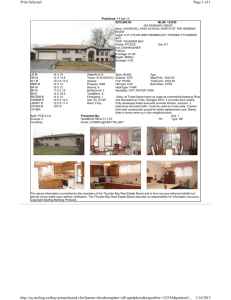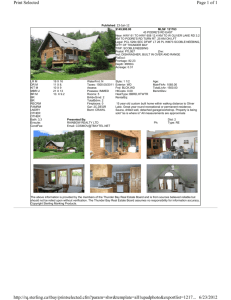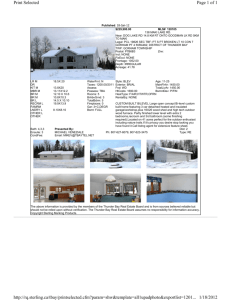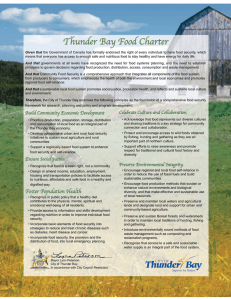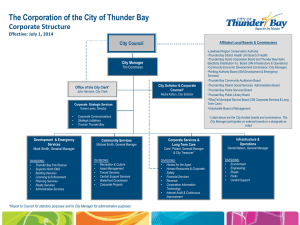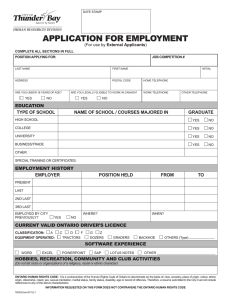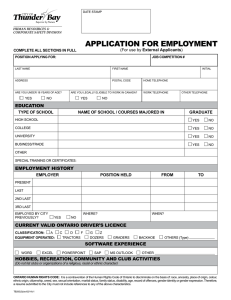Food Policy in Thunder Bay - Ontario Public Health Association
advertisement
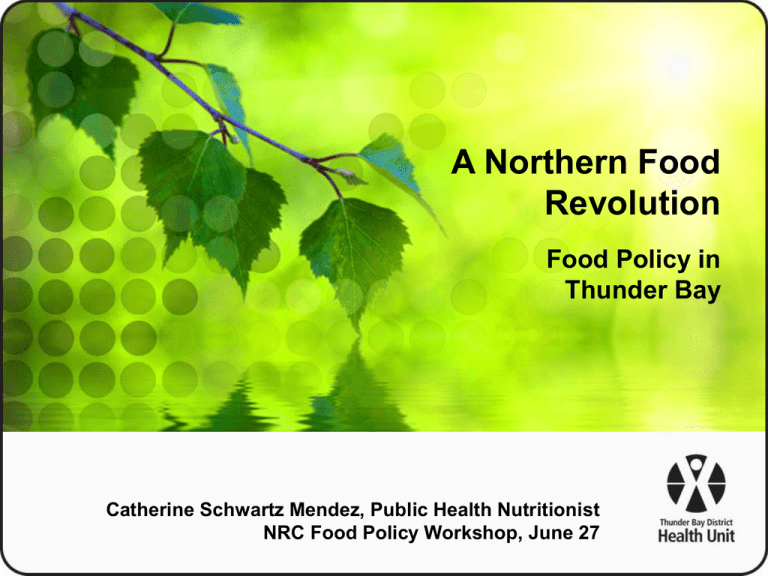
A Northern Food Revolution Food Policy in Thunder Bay Catherine Schwartz Mendez, Public Health Nutritionist NRC Food Policy Workshop, June 27 Food Policy in Thunder Bay 1 Thunder Bay’s Local Food System 2 Food Policy in Thunder Bay 3 Food Policy in Action 4 Lessons Learned A Closer Look at Thunder Bay District • Geographically isolated • Canadian shield • Northern climate • Many First Nations communities, growing urban Aboriginal population • Very active agricultural communities, increasing number of part-time farmers A Healthy Diet Close to Home is Possible! SAD/WLSHD Comparison Local Food Issues Our complex, linear, dependent, industrialized food system: • Food travels great distances to get to us • Higher food prices • Higher cost of a Nutritious Food Basket • Higher food insecurity Industrialized Food System Source: Ministry of Municipal Affairs and Housing (MMAH) Sustainable Food System Source: Ministry of Municipal Affairs and Housing (MMAH) Our Local Food System Who’s doing what? • Northwestern Ontario food agriculture - with unique benefits and challenges! • Food research and education • Food security initiatives - Food Action Network partnerships - Community Gardens - Good Food Box - Farmers’ Markets Food Policy in Action City of Thunder Bay Food Charter • Build community economic development • Ensure social justice • Foster population health • Celebrate culture and collaboration • Preserve environmental integrity Including food in the Community Environmental Action Plan City of Thunder Bay Food Action Network Surrounding Municipalities Thunder Bay District Health Unit Regional Food Strategy Thunder Bay Federation of Agriculture City of Thunder Bay 2011-2014 Strategic Plan Implementation • Strategic Plan supports development of comprehensive local food strategy • To be undertaken by Steering Committee representing food system sectors and area community Thunder Bay and Area Food Strategy Steering Committee Building food into the City of Thunder Bay Official Plan Photo courtesy of Vidioman:http://en.wikipedia.org/wiki/File:Thunder_Bay_City_Hall_2010.jpg Developing a regional food strategy Food Summit March 2012 Food Summit April 2013 Overarching Goals for Food Strategy • To ensure access to healthy food for all • To create food-friendly neighbourhoods that provide enough diverse sources of healthy food and opportunities for community to come together around food • To understand food as a human right, more than a commodity Key Policy Areas – Pillars of Focus • Access to healthy food by ensuring an equitable distribution of food sources ie. retail, food programs etc. • Protect and encourage access to forest and freshwater food sources obtained by hunting, fishing and gathering. Key Policy Areas – Pillars of Focus • Encourage public sector procurement of local, sustainablyproduced food to improve quality of foods served and sold in public venues and encourage institutional buying of healthy local food e.g. Making the Connections for Public Sector Local Food Procurement research by Grey Bruce Centre for Agroecology, February 2013 Key Policy Areas – Pillars of Focus • Protect farm-scale production including agricultural land preservation, capital investment support and new farmer mentorship • Establish food infrastructure for storage, processing, distribution and marketing. Key Policy Areas – Pillars of Focus • Expand urban agriculture including community gardens, backyard chickens, edible landscaping and protect urban forests. • Support a healthy school food environment to ensure access for all to meal and snack programs, embed food literacy in the curriculum, develop school gardens and create healthy food zones around schools. Healthy Eating Makes the Grade • • • • • • • • • • • • • • • • • • Canadian Red Cross Thunder Bay District Health Unit City of Thunder Bay – city planners and city councillor Roots to Harvest 3 School Boards Students Parents Teachers Resource Librarians School Administrators School Board Trustees and Superintendents Cafeteria Staff Daycare Staff Board Purchasers Communications Officers Food Producers and Retailers Lakehead University Wider School Community The Goal of HEMG To improve student health by increasing access to healthier food options in and around schools in Thunder Bay. August 2010 – July 2013 • Heart and Stroke Foundation Spark Grants $5000 + $50,000(2 yrs) • Coordinator, workshops, catering, tour, supplies, teacher release time Working Groups Healthy Food Zones around schools Healthier School Food Choices Youth Food Ambassador Program High School Cafeterias Support for School Food Gardens Build Coalition Capacity Strategic Advantages of Thunder Bay and Area Food Strategy • Historic role of Thunder Bay as transportation and service hub the logical place to centre a regional food strategy • Thunder Bay’s strategic location at the head of Lake Superior protects and opens unique opportunities to link food and employment, food and nutrition, and food and community improvement Healthy Zones around Schools Sow the Seeds School Food Gardens for School Gardens to Grow Student Success Keys to Success of Food Strategy • Making connections • Among city departments • Between city and community • Within the community • Building and strengthening partnerships with a focus on strategy and action It’s a complicated journey! The many challenges: • Serving a large geographic area with diverse communities/needs • Navigating city departments – who does what? • Transitioning from grassroots to a more formal political process, while still giving voice to people experiencing food insecurity • Balancing political agendas that sometimes conflict with evidence • Addressing the mismatch between legislation and current needs (i.e. use of traditional foods such as wild meat cannot be inspected; lack of bylaws re: raising poultry in city limits) • Acknowledging very diverse perspectives, goals (ie. addressing hunger vs shifting food system; safe food vs healthy food) • Dealing with lack of physical infrastructure to support the small farmer serving a small population (i.e. poultry processing facility limited in moving forward due to high funding and requirements) Lemons to Lemonade! Lessons learned: • Use technology to communicate. • Recruit champions on city council and in city administration. • Build relationships with a wide variety of stakeholders. • Build education into meetings to learn from varying perspectives. • Harness the media and have designated well-prepared spokespeople. Thank you! catherine.schwartz@tbdhu.com
